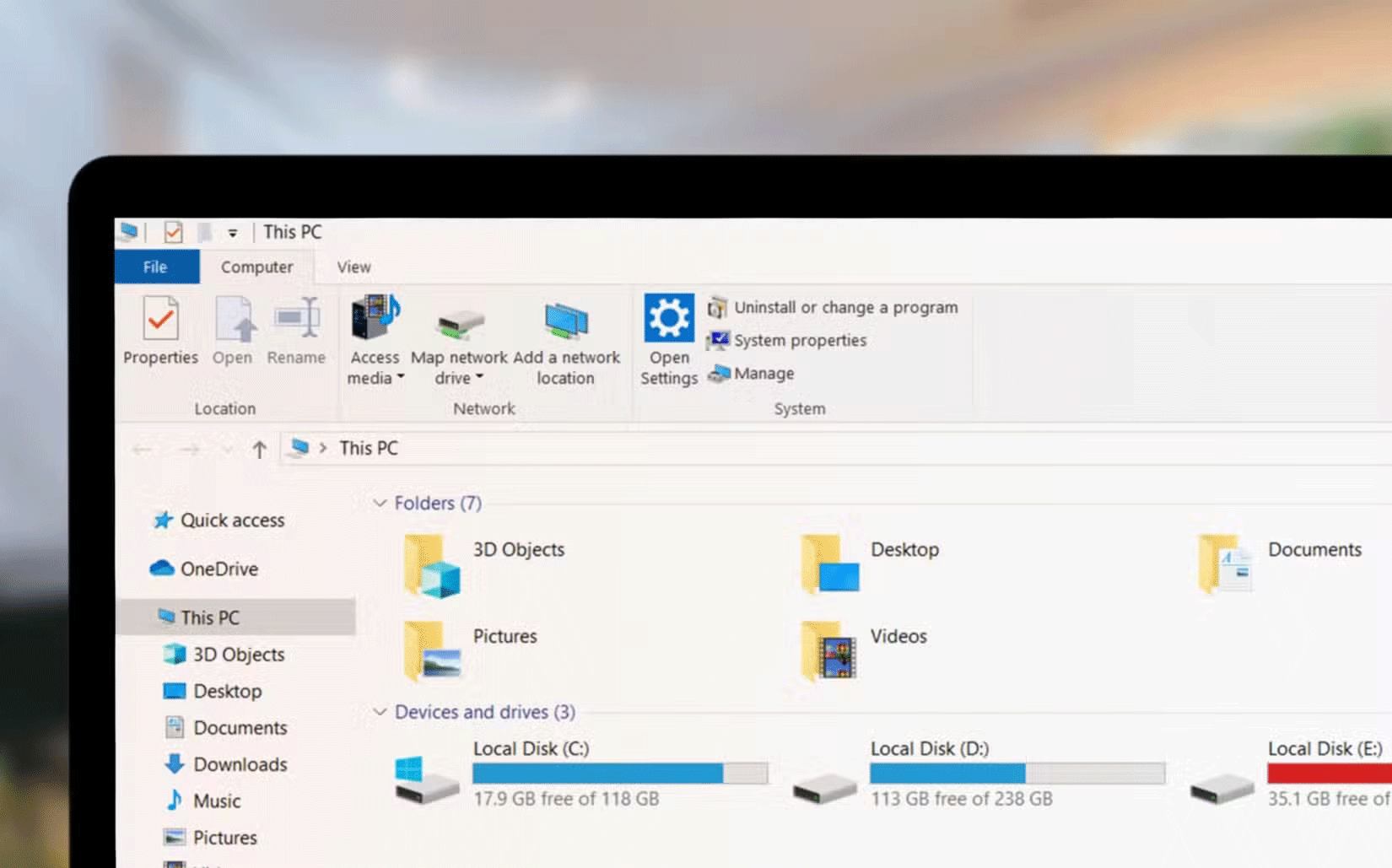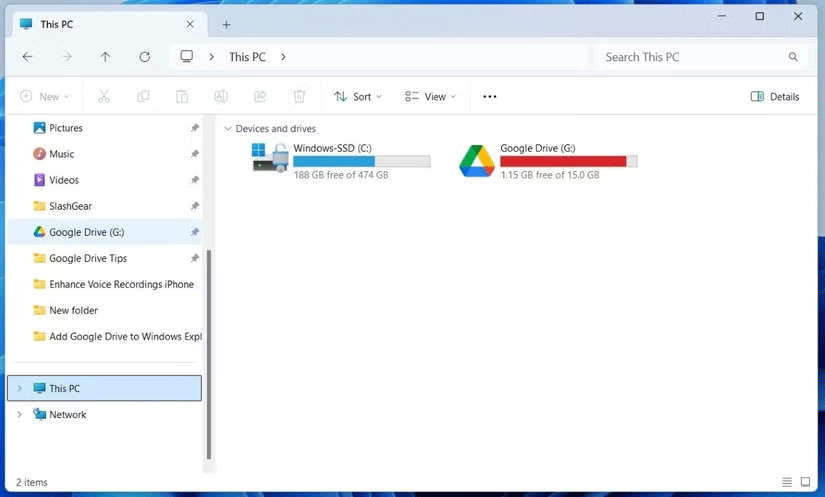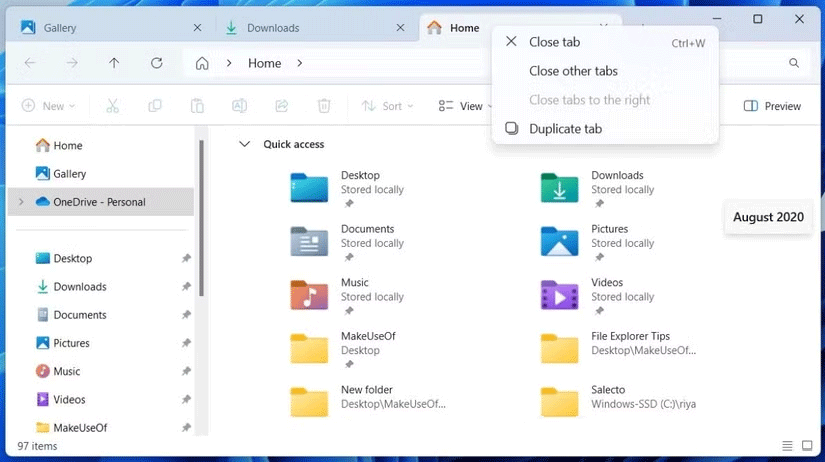Why do many people prefer Windows File Explorer over macOS Finder?
When it comes to file management, both Windows File Explorer and macOS Finder have their strengths. However, if you are a user of both systems, many people still come back to File Explorer because of its simplicity and more user-friendly features.
1. Easy to navigate from the start

Windows File Explorer makes navigation more seamless from the moment you open the app. Features like the navigation bar and toolbar are built in, so you don't have to adjust settings to access them.
In Finder, these handy tools aren't visible by default—you have to dig into the settings to enable them, so some users may not even realize they exist. It's a small detail, but it makes File Explorer feel more intuitive right out of the box.
2. Default access to hard drive for fine-tuned file management

File Explorer gives you instant access to your hard drives and important system files directly in the Pinned Folders area. This makes it easy to jump to important system files when you need them.
Accessing your hard drive requires extra steps with Finder. In fact, you have to enable a setting to show your hard drive on your Mac. This is a small thing Apple does to prevent people from editing files they shouldn't be touching.
However, the fact that most people can use a Mac for years without ever realizing this setting exists is another reason why many people prefer File Explorer's "show up front and trust the user" approach.
3. File Explorer organizes everything better

One of the most popular features of File Explorer is its hierarchical organization system. The left-side tree view is a game-changer for quickly navigating through folders and subfolders.
Finder lacks this level of clarity, making it difficult to delve into nested folders. For users who deal with a lot of folders, File Explorer's structure is streamlined and easier to navigate, saving time and frustration.
4. Move multiple file types using cut/paste
While Finder requires a keyboard shortcut to cut and paste files, File Explorer provides this option directly in the context menu. Sure, keyboard shortcuts are convenient, but sometimes it's easier to use the menu—especially if you're explaining the process to someone who isn't familiar with keyboard shortcuts, like an elderly relative.
There's also the fact that the Mac's Finder doesn't support using copy/paste to move anything other than text. Sure, you can use a little Mac workaround to move files around more easily, but Windows' File Explorer makes things simple from the get-go. It's a small improvement, but it highlights one of the ways File Explorer is accessible to everyone.
The Mac's Finder has its advantages, especially when working within the Apple ecosystem. However, when it comes to ease of use, organization, and quick access to essential features, Windows File Explorer is still the superior file manager.
Whether you're a tech-savvy user or a beginner, File Explorer strikes the perfect balance between simplicity and functionality, making it hard to beat.
You should read it
- Steps to fix slow Windows File Explorer
- Fix File Explorer error not working on Windows 10
- How to fix Working On It on File Explorer Windows 10
- 5 best Windows File Explorer extensions to manage files on the system
- 7 notable changes in File Explorer Windows 11
- 9 outstanding features of Solid Explorer you may not know
- 10 indispensable features of File Explorer
- Finally, Microsoft also adds a tabbed interface to File Explorer on Windows 11
May be interested
- 3 reasons macOS is better for programming than Windows
 many programmers have worked with both mac os x and windows operating systems. they have understood why many people prefer the macbook. join tipsmake.com to learn about 3 reasons macos is better for programming than windows through the following article.
many programmers have worked with both mac os x and windows operating systems. they have understood why many people prefer the macbook. join tipsmake.com to learn about 3 reasons macos is better for programming than windows through the following article. - Steps to fix slow Windows File Explorer
 if you have to manage and work with files on a daily basis, file explorer performance issues can significantly hinder your productivity. fortunately, there are different ways to fix slow or unresponsive file explorer.
if you have to manage and work with files on a daily basis, file explorer performance issues can significantly hinder your productivity. fortunately, there are different ways to fix slow or unresponsive file explorer. - 7 Useful Changes Microsoft Should Make to File Explorer
 file explorer is still an important part of windows, and with a few smart updates, microsoft could improve things even more for users.
file explorer is still an important part of windows, and with a few smart updates, microsoft could improve things even more for users. - A series of leaked photos shows that File Explorer is about to receive a complete design overhaul on Windows 11
 file explorer is one of the areas most frequently interacted with by users on windows in general, so any changes in this area will have a big impact on the operating system experience.
file explorer is one of the areas most frequently interacted with by users on windows in general, so any changes in this area will have a big impact on the operating system experience. - Restore lost File Explorer icons on Windows 10 Start Menu
 by default, windows 10 displays the file explorer icon in the lower left corner of the start menu, as well as on the taskbar so that users can easily open file explorer quickly.
by default, windows 10 displays the file explorer icon in the lower left corner of the start menu, as well as on the taskbar so that users can easily open file explorer quickly. - Summary of ways to open File Explorer on Windows 11
 similar to previous versions of windows, file explorer is an essential part of windows 11, helping users manage their files and folders in a simpler, more scientific way.
similar to previous versions of windows, file explorer is an essential part of windows 11, helping users manage their files and folders in a simpler, more scientific way. - Fix File Explorer not responding error in Windows 11/10
 if file explorer is not working, you will not be able to access files, folders, and drives on your computer. you can find below the steps to fix file explorer not responding issue in windows 10/11.
if file explorer is not working, you will not be able to access files, folders, and drives on your computer. you can find below the steps to fix file explorer not responding issue in windows 10/11. - Here's how to make the File Explorer Windows 10 interface look like File Explorer Windows 7
 some users do not like the new file explorer interface. if you like windows 7's file explorer interface or simply don't like the ribbon menu on the new file explorer interface, you can easily change the file explorer interface to the file explorer interface on windows 7.
some users do not like the new file explorer interface. if you like windows 7's file explorer interface or simply don't like the ribbon menu on the new file explorer interface, you can easily change the file explorer interface to the file explorer interface on windows 7. - How to hide / show the status bar in File Explorer on Windows 10
 the status bar at the bottom of file explorer tells you how many items are inside and selected for the currently open folder. the two buttons below are also available on the right side of the status bar.
the status bar at the bottom of file explorer tells you how many items are inside and selected for the currently open folder. the two buttons below are also available on the right side of the status bar. - How to delete folder and file search history in Windows Explorer?
 on windows operating systems (windows 7, windows 8, windows 10), windows explorer remembers the location of files and folders when you type in the address bar on windows explorer. the files and folders when you enter will be displayed automatically accessible by clicking the down arrow at the end of the address bar to drop down the list.
on windows operating systems (windows 7, windows 8, windows 10), windows explorer remembers the location of files and folders when you type in the address bar on windows explorer. the files and folders when you enter will be displayed automatically accessible by clicking the down arrow at the end of the address bar to drop down the list.









 How to Create Animated Sound Using Adobe Express
How to Create Animated Sound Using Adobe Express Step by Step Guide to Connect Spotify to Gemini
Step by Step Guide to Connect Spotify to Gemini Handy Galaxy Features iPhone Users Wish They Had
Handy Galaxy Features iPhone Users Wish They Had 4 Ways AI Is Making Smart TVs Better
4 Ways AI Is Making Smart TVs Better How to turn off Instagram post comments
How to turn off Instagram post comments Excel 2016 - Lesson 7: Formatting Excel spreadsheets - Complete guide to Excel 2016
Excel 2016 - Lesson 7: Formatting Excel spreadsheets - Complete guide to Excel 2016